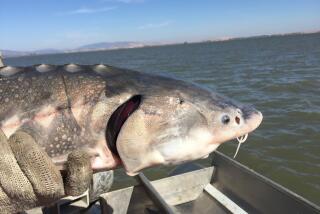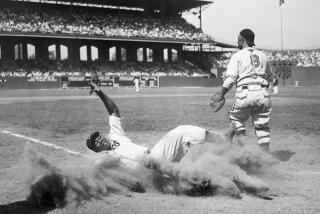Chasing the Bass Ring
- Share via
On a roadside in rural southeastern Georgia, not far from the Ocamulggee River, there’s a monument to one of the most coveted records in sports. It was there, in 1932 at tiny Montgomery Lake, that George Perry caught a world-record 22-pound, four-ounce largemouth bass.
Perry’s record still stands, as seemingly insurmountable as Maris’ 61-home run season or Chamberlain’s 100-point game.
“After all these years, I am amazed no one’s caught one bigger,” said Chris Martin, a biologist with the Georgia Department of Natural Resources. “I’m sure there’s probably a bigger bass out there, but it’s a funny thing about fish like that. They get big because they don’t get caught.”
There are many people who believe that at this very moment a fish--the fish--capable of toppling Perry’s record is swimming around Lake Castaic or Lake Casitas.
“This is what I tell anybody who gets in my boat,” says Gary Harrison, a popular Castaic fishing guide. “Every time you put your bait in the water there’s a possibility of catching a world record.”
Largemouth bass are the most popular gamefish in the United States. To amateurs, the world record means becoming part of folklore. To professionals, a world record is probably worth $1 million in endorsements from the recreational fishing industry, which generates $3 billion a year in sales.
“Catching that fish,” said pro fisherman Aaron Martins, “would be like winning the lottery.”
Martins is among those who believes he had a run-in with the winning ticket.
“I saw the world record at Casitas,” said Martins. “It was two years ago. I was fishing with a friend and we were in shallow water. I saw this fish swim by and it had to be about 25 pounds. I was trying to tell my friend but I couldn’t breathe.”
“I’ve seen two fish in Castaic which totally blew my mind,” said Buck Bauernfeind, a pro bass fisherman, guide and manufacturer of rod racks. “One of them only had one eye. I could see it that good. It just looked at me with that one eye, like it was saying, ‘You wish.’ ”
“Once I had one on the line at Castaic and we saw it before it broke the line and we think it was one of those fish,” said Harrison, the guide. “When I came home, I was white as a sheet and I couldn’t talk. My wife said, ‘What happened to you? Were you in a wreck?’
“I couldn’t say anything. It’s the kind of thing that haunts you every day.”
*
Mounted on the living-room wall of an ordinary L.A. home is an extraordinary fish. It’s 27 inches long and weighs 21 pounds, 12 ounces. The fish’s mouth is open; a softball could easily be inserted in the mouth without touching any of the sides.
“That’s the largest largemouth ever officially weighed and mounted,” said Mike Arujo. “I only missed the record by half a pound. All my fish had to do was eat once more that morning and I would have been there.”
Arujo caught his fish at Castaic’s upper lake on March 5, 1991. A biologist from the state Department of Fish & Game studied the scales of the fish and estimated it to be between 13 and 15 years old--which puts the fish at the far end of its species in age.
A week later, policeman Bob Crupi caught a 22-pound largemouth in almost the identical place on the lake. But what Crupi did next raised some eyebrows. The fish was about to spawn. So, after having the fish weighed and photographed, Crupi released it before a biologist from the DFG could arrive to examine it.
“Basically, [the DFG] wanted a dead fish,” said Crupi. “If that’s the kind of people they want to be, so be it. It was a hard decision, but my thinking at the time was that it was better to release the fish and keep the gene pool going.”
It may have been a noble decision, but it cost Crupi the state record, which was retained by Arujo and his fish. Nevertheless, Crupi’s fish was recognized by the International Game & Fish Assn. as the second-largest largemouth ever caught. Crupi had also caught a 21-pound, 7-ounce bass at Castaic in 1990, making him the only person to ever catch two largemouth bass in excess of 20 pounds.
What does it take to produce such large fish?
Castaic had several things going for it in the early 1990s, according to Terry Foreman, a DFG fishery biologist. It was a relatively new reservoir--it opened in 1972--and the water contained large amounts of nutrients, which provided the foundation for a healthy food chain. Largemouths also had little competition for food, fattening up on shad and the large numbers of trout the DFG planted in the reservoir.
“In that kind of situation, what happens is the fish grow disproportionate with their length,” said Foreman. “We have fish in there now that are the same size, but they don’t weigh nearly as much as they used to because there is competition for food.”
At Castaic, three things have happened since 1991. A growing population of striped bass have found their way into the lake from the California Aqueduct and are competing with the largemouths for food. The DFG has also reduced the amount of trout it puts in the upper lake, meaning the stripers and the largemouths have to compete for less food. And, of course, the fishing pressure on the upper lake has been enormous; most people consider Castaic’s lower lake to be the place to fish.
Simultaneously, the conditions at Casitas have greatly improved in the last few years.
Diego Busatto, another fisheries biologist with the DFG, did a survey of Casitas in April. After using electronarcosis to temporarily paralyze fish in the lake, Busatto said he counted at least 15 to 20 fish that weighed more than 15 pounds.
Busatto added: “A fish that’s mature and ready to spawn could go over 22 pounds.”
*
In February, angler Paul Duclos caught a huge largemouth bass at Spring Lake, near Santa Rosa. He immediately phoned home to his wife, who brought a bathroom scale to the lake.
Duclos weighed himself holding the fish and then without it and subtracted the difference: 24 pounds. After taking some photos, Duclos threw the fish back into the lake.
There are two problems with this. One, none of the sanctioning fish organizations will recognize a fish weighed on a bathroom scale. Two, a DFG biologist didn’t get a chance to examine the fish. So, George Perry’s world record continues to stand.
“I saw the photos and it was a nice fish,” said Arujo. “But it wasn’t as big as my fish.”
And the hunt goes on.
More to Read
Go beyond the scoreboard
Get the latest on L.A.'s teams in the daily Sports Report newsletter.
You may occasionally receive promotional content from the Los Angeles Times.










